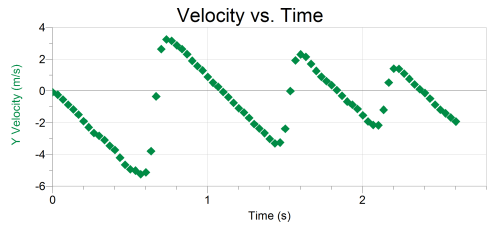Nothing earth-shattering here. I just wanted to share the activity we worked on today, which was an introduction to quantitative energy conservation by doing a video analysis of a bouncing ball. (Up until now, we were only doing qualitative energy pie charts.) Here are the handouts and the video:
- PreLab: Energy of a Bouncing Ball 2013 (docx)
- Lab: Energy of a Bouncing Ball 2013 (docx)
- Ball Bounce Video (avi) — From Ball State’s Video Analysis: Real World Investigations for Physics and Mathematics
The graphs from the analysis are just beautiful:
Lots to talk about in those graphs!
Feel free to edit and reuse the handouts as you see fit. They’re not perfect, but I figure it’s better to share them than having them collect dust on my flash drive.
PS: I’ll sheepishly admit that I don’t do the whole suite of paradigm labs in the Modeling unit to mathematically derive the energy equations from experiments. But we do some simple qualitative demos/experiments to discover what variables would be in those energy equations. We start by talking about how the further a rubber band is stretched, the more energy it stores. Then we launch carts into a rubber band “bumper” (i.e., big rubber bands from Staples and two C-clamps) to qualitatively see the energy stored.
In doing so, we see that the cart’s kinetic energy depends on its speed and its mass. (Or is it weight? What would happen if we repeated the experiment on the moon?)
For gravitational energy, we can repeat the experiment, but have carts rolling down an incline. Or use the rubber band to launch the cart up the incline. I’ve also dropped balls into sand and looked at the depth to which they get buried. Either way, we see that gravitational energy depends on height and weight. (Or is it simply mass? What would happen on the moon?)
For elastic energy, we already know it depends on the distance the rubber band is stretched. Then, we can swap out the rubber band in the bumper with a stiffer/looser one to see the effects of the spring constant on energy stored.
Then, after we predict what the energy equations might look like, I just give them the actual energy equations, or have them look them up. (Gasp! See Schwartz’s A Time for Telling, aka Preparation for Future Learning.)
So, modelers, what am I missing by not doing the full-blown energy paradigm labs? How do you introduce the quantitative energy equations?






